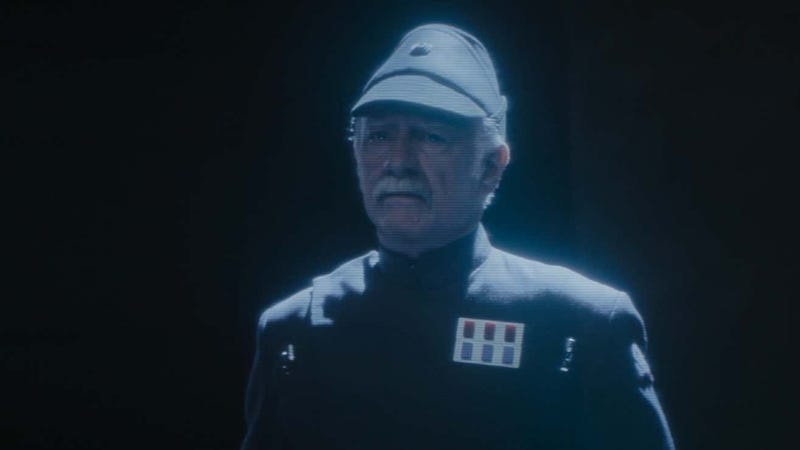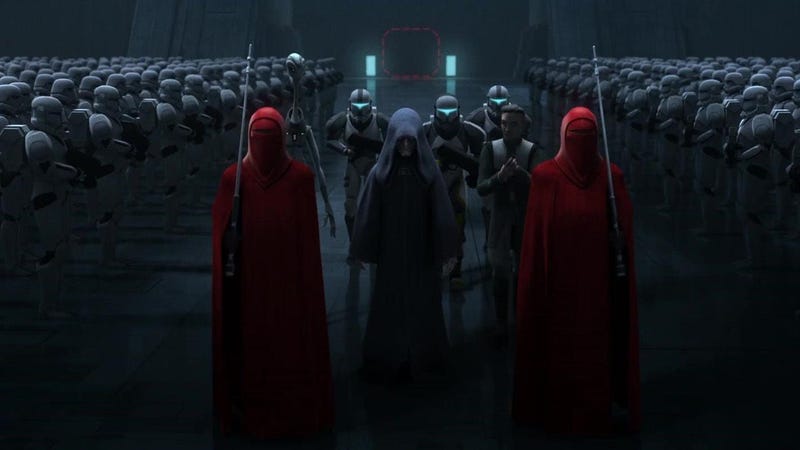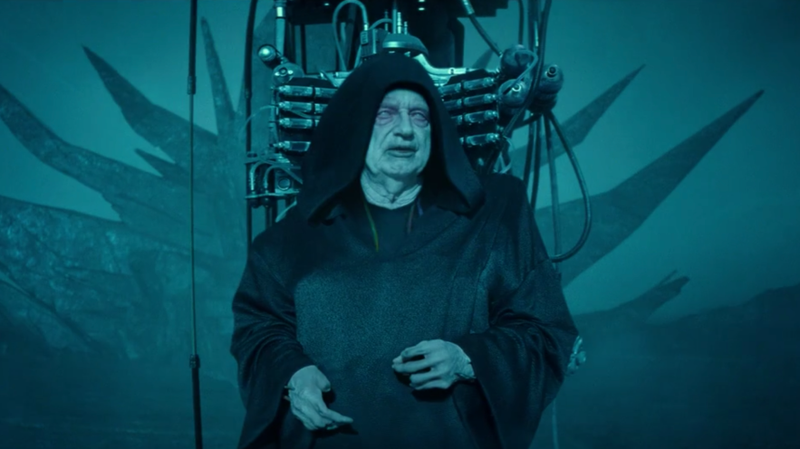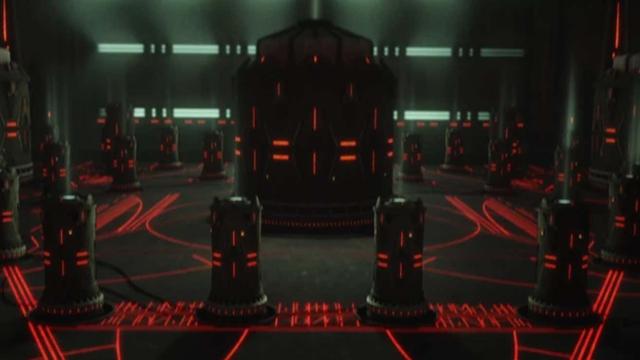When The Bad Batch returned for its third and final season this week, it made clear its endgame will attempt to tie up something Star Wars has been obsessed with for nearly five years now: how, exactly, did Palpatine return? We’ve long had the answer, but the saga, and now Bad Batch itself, hopes to explain with two simple words: Project Necromancer.
First mentioned in The Mandalorian’s third season, Project Necromancer has now been established as an even longer-running pet project of Palpatine and Dr. Royce Hemlock, spinning out of an Imperial scientific research facility at Mount Tantiss on the planet Weyland. With big ties to our heroes, and even bigger ties to Star Wars’ expanded universe past, Necromancer is slowly but surely making a name for itself as one of the galaxy far, far away’s biggest fascinations of late. But what do we actually know about it already—and what can we infer from what Star Wars has told us?

What Actually Is Project Necromancer?

Project Necromancer was first mentioned in the Mandalorian season three episode “The Spies,” in a single line uttered by Shadow Council member—and EU returning support star as the right hand of Grand Admiral Thrawn—Captain Gillad Pellaeon. There, the project is mentioned as being under the auspices of Brendol Hux (the father of Armitage Hux from the sequels), with the return of Thrawn to the Imperial Remnant’s military intended to buy Hux time to deliver on Necromancer. With a name like “Necromancer,” Star Wars fans immediately pegged it as a reference to whatever plans were made by the upper echelons of the Imperial order to return Palpatine to life in some form.
The third episode of this week’s Bad Batch season three premiere, “Shadows of Tantiss,” made that reference explicit. Palpatine himself arrived at Mount Tantiss to get an update on the project from Imperial research scientist Doctor Hemlock, and went a little further: Necromancer sought a clone template with a viable M-Count, one that it was struggling to find… until Omega’s blood passed testing thresholds.
How Long Has Palpatine Been Working on Necromancer?

Bad Batch also makes it clear that Project Necromancer wasn’t just something that came up once Palpatine perished aboard the second Death Star, as this is now the earliest mention of its direct existence in the Star Wars timeline. With Bad Batch set in the earliest days of the Imperial regime, it’s now clear that cheating death was pretty much immediately on Palpatine’s mind even as he ascended to power—perhaps even because of it, after his scarring encounter with Mace Windu at the climax of Revenge of the Sith.
And that’s only as far as we know, too—there’s always the chance down the line it will be revealed that Necromancer was in the works even earlier. After all, Mount Tantiss is a pretty elaborate facility to have been wound up the moment the Republic became the Empire. Necromancer could very well have had roots in Republic science projects during the Clone War, just with a slightly less “Hey This Is Probably Pretty Evil” name.
What Is an M-Count?

One of the few tidbits we learn in The Bad Batch’s season three premiere is that Necromancer needs a clone sample with a suitable “M-Count” if it’s to work. While most of the characters we follow in the show are unfamiliar with what that term means beyond Hemlock and Palpatine—and subordinates like Emerie Karr, herself a clone, and Kaminoan scientist Nala Se—it’s one that will immediately set alarm bells ringing for a Star Wars fan. What else could M-Count be about, if not midi-chlorians?
The biological component first introduced in The Phantom Menace as a way to quantify an individuals capacity for Force sensitivity, midi-chlorians are the tiny, intelligent beings that bind the organic beings of the galaxy, through which the power of the Force flowed. Palpatine and Hemlock’s search for a test candidate with a high enough midi-chlorian count is obvious, all things considered: Palpatine desires a suitable vessel for his own power.
Does Project Necromancer Make Rey’s Dad?

This is where things mostly get speculatory. We know that Rey’s father, Dathan, was a strandcast clone that disappointed Palpatine with his lack of Force sensitivity, and Hemlock does mention to Palpatine in Bad Batch that Necromancer has already produced one “successful transfer,” albeit with a low M-Count. Could this be Dathan?
Palpatine’s son was “born” in 12BBY, as far as we currently know, so while we don’t have an entirely definitive time frame for The Bad Batch’s third season just yet, that could be a little too late for the chronology we’re working with here. Maybe things could be fudged here to make that date still work; perhaps Dathan was created on Tantiss, before being sent to Exegol in his youth after Palpatine grew frustrated with his lack of viability?
What Does a Viable M-Count Mean for Omega?

“Shadows of Tantiss” climaxed Omega and Crosshair’s escape from Weyland with the revelation that Nala Se had been destroying Omega’s blood samples to avoid one major revelation: Omega had a viable M-Count for Project Necromancer. Which would mean, presumably, were she to awaken to it, Omega is capable of wielding the Force in some manner, perhaps even significantly so.
This is maybe not surprising—ever since Bad Batch began, the theories around what made Omega as much a “defect” as the other members of Clone Force 99 have swirled around the idea of her being a clone with high Force sensitivity. Although subtle in many ways, she’s regularly been shown to be empathetic beyond just normal means, able to intuit emotions and feelings around events before they occur, which were all seen as potential instances of an untrained Force user using their skills without fully realizing it. It seems that with Bad Batch season three preparing us to expect its endgame to swirl around events at Mount Tantiss, at some point Omega is going to take her first steps into an even larger world she’s escaped back into.
What Does Project Necromancer Mean for Force Sensitivity and Clones?

The idea of a Force sensitive clone isn’t at all surprising—it’s an idea that was explored repeatedly in Star Wars’ old Expanded Universe, and in contemporary canon we’ve known the potential is possible, considering that’s how Palpatine ultimately returned in Rise of Skywalker. But one interesting thing that Bad Batch has subtly brought to the fore in this mix that was lacking in the Expanded Universe’s exploration of the concept is that, well, clones are actually also as much their own people in the tapestry of the Force as they are copies of someone else.
Omega being Force sensitive while Jango Fett is not doesn’t mean anything in continuity; neither does the fact that Dathan could be made from Palpatine’s own genetic material and not inherit his power. Whereas in the old EU, in beings like the myriad clones of the Emperor in Dark Empire or—to keep things close to Mount Tantiss—clones like Luuke or Joruus C’baoth, cloning Force sensitivity was as easy as any other kind of cloning: it just kind of happened when you copy-pasted a being strong in the Force. This adds not just an individuality and humanity to clones in a way that very much works with what Bad Batch has been exploring about the life of the clone army after the Empire has run out of uses for it—it doesn’t matter who they are or who they were made out of, they too have this organic connection to the living beings of the whole galaxy on a spiritual level, and can grow to learn how to tangibly interact with that connection—it also helps sell the fact that what Palpatine was trying to do was hard, and desperate, and oddly pathetic.
The fact that it took him decades of tinkering with lavish secret experiments to even get the shriveled husk we see in Rise is a testament to that desperation, and something that makes centering Palpatine as the root of so many evils in Star Wars feel at least most dramatically interesting. The Force will work however it wants to, and speak to whoever it wants to, instead of being bent to an exact science and the will of a tyrannical monster. It’s a nice balance between the metaphorical hand grenade the existence of midi-chlorians brought with it 25 years ago, and an age-old ideal of Star Wars: that anyone can tap into this power with enough practice and will.
What Is Project Necromancer’s Legacy Beyond Palpatine?

It’s hard to say just yet how much this will, if anything, spiral beyond simply following a trend of what Star Wars has done regularly in recent years—attempt to retroactively lay in context and connections to the events of The Rise of Skywalker across multiple generations and periods of Star Wars that came before it. But it’s not like there aren’t seeds.
We already saw Moff Gideon experimenting on his own smaller scale version of Necromancer by creating clones of himself that harvested material from Grogu in an attempt to create force sensitive soldiers in The Mandalorian. And now, in Omega, we have another story to see unfold beyond Palpatine’s machinations as Bad Batch season three progresses. But it doesn’t stop there, especially with Mount Tantiss in play—even more elements from the Heir to the Empire trilogy like the aforementioned Luuke and Joruus are potentially on the table given that we know Dave Filoni’s Imperial Remnant vs New Republic movie is going to lean on inspirations from those iconic books. Hell, it doesn’t just have to be Palpatine, either—that could lead to even more wild stuff with Thrawn from the old EU, like his own cloning plans and the Empire of the Hand.
Suffice to say, Necromancer opens up a lot of interesting potential beyond paving the way to The Rise of Skywalker, should Star Wars actually want to use it beyond that. Time will tell…
